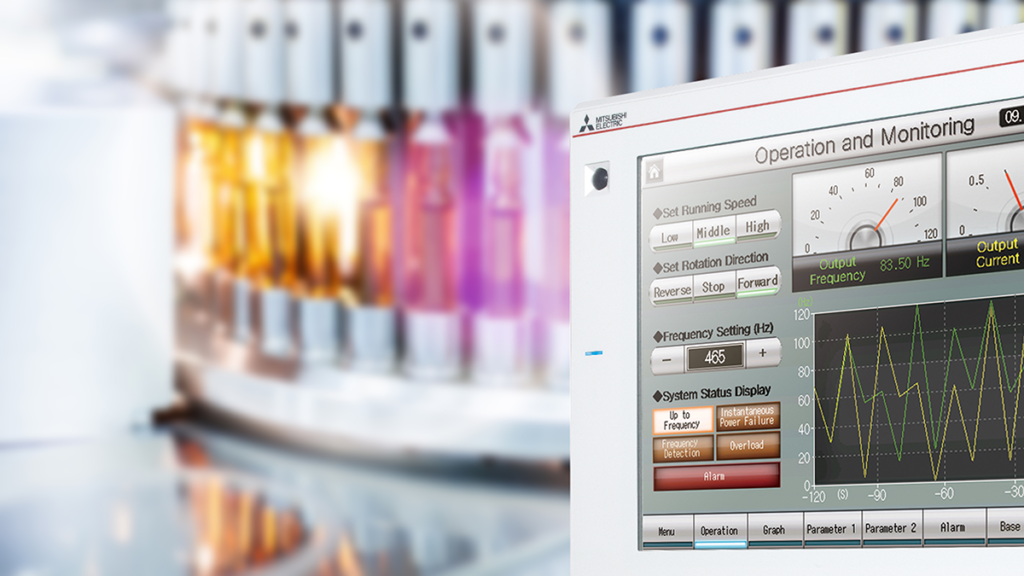The vision of futureproof, automated factories is one of high-speed, agile production lines capable of quickly delivering products to customers. The backbone of these automated systems are the perhaps less visible servos and HMIs, which are key for precision motion and control. Thanks to its large portfolio of drives and operator terminals, Mitsubishi Electric can provide companies with the components they need to create successful automation applications.
Servos and HMIs play a key role in many applications of industrial automation, as they provide the tools for motion-based activities and for real-time control, respectively. While servos are responsible for moving machine parts with high precision, HMIs provide a platform that maximises data availability and enables accurate process visualisation. Since these components greatly contribute to defining the effectiveness of an automated system, companies need to identify the features and capabilities that are best suited to their application.
Selecting servos for maximum performance
Investing in high-performance servos that maximise uptime enables companies to create ambitious high-speed automated systems with exceptional position accuracy. This means specifying robust components that can also offer future-oriented diagnostics and predictive maintenance functions. To this end, selecting a drive that supports communications with both the IT and OT levels of a business can provide an opportunity to gain more comprehensive actionable insights.
To get the most out of existing manufacturing footprints, compactness is another key aspect to consider. Looking at the dimensions of servo motors and amplifiers is a good starting point. Other features that can greatly help reduce the space required by a device include reduced cabling and battery-less solutions. Finally, the ability of servos to handle multiple axes, incorporate safety functions without the need for specific modules as well as the possibility to use one single amplifier to control multiple motors are key to reduce the bill of materials.
An example of a solution that can address all these needs is Mitsubishi Electric’s MELSERVO MR-J5 range of CC-Link IE TSN compliant servos. This new series of servo motors and amplifiers was presented for the first time to the UK market at Drives & Controls 2022.
The servo systems offer next-level performance in terms of cycle times, accuracy and control of multiple axes, up to as many as 768. To support compactness and flexibility the MR-J5 range does not require a battery and needs minimal cabling, even when connected to multiple motors. It also incorporates safety communications, in addition to TSN functions for next-level data availability and convergence. Finally, it provides AI-powered advanced diagnostic functions and condition monitoring capabilities to prevent unexpected downtime and optimise maintenance.
Maximising enterprise-wide visibility with the right HMI
It is often believed that HMIs are all identical and there is limited scope for evolution in the technology that underpins these platforms. However, these statements could not be further from the truth.
There are certainly a number of core functionalities that anyone would expect these interfaces to have, such as real-time data logging and handling, the ability to back up and restore key elements and the possibility to use SD cards.
In addition, a future-oriented HMI should be able to support the main principles of Industry 4.0, particularly interoperability, decentralisation and service-orientation.
Especially the ability to connect this type of system to any device without the need for dedicated networks or monitors is becoming increasingly important.
Furthermore, to turn any screen into an HMI can be highly beneficial, as companies can maximise flexibility as well as support for remote monitoring. By offering web-based access, an HMI provides operators with a cost-effective solution for checking the shop floor and controlling devices from anywhere through a web browser.
Even more, it can be used by companies to display multiple interfaces on a single screen and gain a comprehensive overview of all activities as well as their status.
Finally, an advanced platform should streamline and simplify the creation of new HMI projects and recipes. This is key to shortening implementation times while also helping less experienced users set up systems in line with an existing automation infrastructure and its needs.
Mitsubishi Electric can address these requirements with its range of visualisation solutions. In addition to its GOT 2000 HMIs, the company offers smart, web-based remote access via GOT mobile, which supports up to five simultaneous and independent connections to worksite interfaces. Systems like this usually require users to log in and validate their credentials every time. However, to streamline this process, Mitsubishi Electric has developed GOT mobile ANDON to support pre-authentication, allowing authenticated users to add an approved device. This can be useful, for example, when a large screen is used to supervise or look at operations to showcase factories in visitor centres.
Another tool that makes HMI operation even more practical, is Soft GOT. This software runs on computers, such as industrial PCs, and is used to monitor and operate industrial devices that are connected to the computer via a network. It maximises flexibility, as companies can repurpose their PCs as HMIs. Thanks to the GOT Link function, it is also possible to run up to four different interfaces on a single screen.
Finally, Mitsubishi Electric’s data utilisation capabilities across the entire GOT range empower users to upload standard or existing projects to the HMI without requiring any additional programming.
Visitors to Drives & Control 2022 were able to learn more about all these features as well as watch them in action on stand F100, where two large 12-inch HMIs were displaying the status information of connected drives. It was also possible to view a GOT 2000 HMI connected to a vision system, in addition to standard drives and controls, without the need for a separate screen.
Advanced HMIs and servos, such as Mitsubishi Electric’s solutions, are enabling technologies for the creation of future-oriented high-precision automation projects. By leveraging these, companies can succeed in the creation of high-speed, agile production lines that can promptly deliver products to customers.
